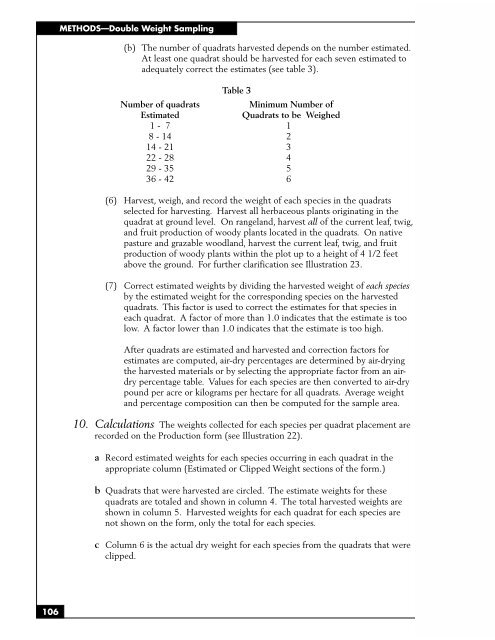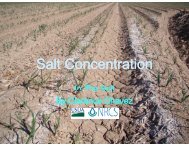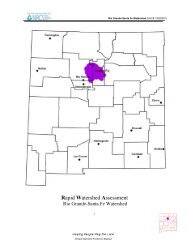SAMPLING VEGETATION ATTRIBUTES - New Mexico NRCS - US ...
SAMPLING VEGETATION ATTRIBUTES - New Mexico NRCS - US ...
SAMPLING VEGETATION ATTRIBUTES - New Mexico NRCS - US ...
You also want an ePaper? Increase the reach of your titles
YUMPU automatically turns print PDFs into web optimized ePapers that Google loves.
106<br />
METHODS—Double Weight Sampling<br />
(b) The number of quadrats harvested depends on the number estimated.<br />
At least one quadrat should be harvested for each seven estimated to<br />
adequately correct the estimates (see table 3).<br />
Number of quadrats<br />
Table 3<br />
Minimum Number of<br />
Estimated Quadrats to be Weighed<br />
1 - 7 1<br />
8 - 14 2<br />
14 - 21 3<br />
22 - 28 4<br />
29 - 35 5<br />
36 - 42 6<br />
(6) Harvest, weigh, and record the weight of each species in the quadrats<br />
selected for harvesting. Harvest all herbaceous plants originating in the<br />
quadrat at ground level. On rangeland, harvest all of the current leaf, twig,<br />
and fruit production of woody plants located in the quadrats. On native<br />
pasture and grazable woodland, harvest the current leaf, twig, and fruit<br />
production of woody plants within the plot up to a height of 4 1/2 feet<br />
above the ground. For further clarification see Illustration 23.<br />
(7) Correct estimated weights by dividing the harvested weight of each species<br />
by the estimated weight for the corresponding species on the harvested<br />
quadrats. This factor is used to correct the estimates for that species in<br />
each quadrat. A factor of more than 1.0 indicates that the estimate is too<br />
low. A factor lower than 1.0 indicates that the estimate is too high.<br />
After quadrats are estimated and harvested and correction factors for<br />
estimates are computed, air-dry percentages are determined by air-drying<br />
the harvested materials or by selecting the appropriate factor from an airdry<br />
percentage table. Values for each species are then converted to air-dry<br />
pound per acre or kilograms per hectare for all quadrats. Average weight<br />
and percentage composition can then be computed for the sample area.<br />
10. Calculations The weights collected for each species per quadrat placement are<br />
recorded on the Production form (see Illustration 22).<br />
a Record estimated weights for each species occurring in each quadrat in the<br />
appropriate column (Estimated or Clipped Weight sections of the form.)<br />
b Quadrats that were harvested are circled. The estimate weights for these<br />
quadrats are totaled and shown in column 4. The total harvested weights are<br />
shown in column 5. Harvested weights for each quadrat for each species are<br />
not shown on the form, only the total for each species.<br />
c Column 6 is the actual dry weight for each species from the quadrats that were<br />
clipped.




